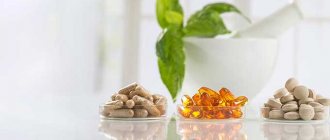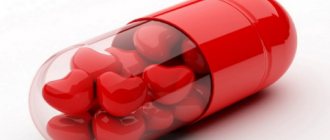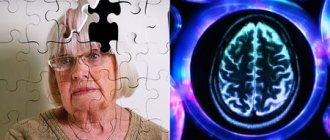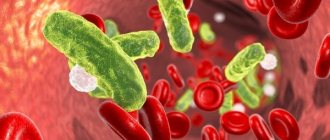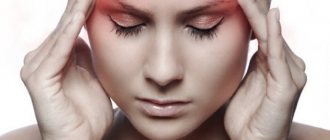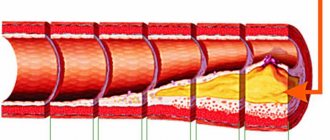When the tone of the capillaries and arteries decreases, venous insufficiency develops, a malfunction of the heart occurs, and brain function deteriorates. It is necessary to monitor warning signs to prevent cardiovascular complications. To strengthen blood vessels and reduce their fragility, medications and vitamins are used. Folk remedies and gymnastics help improve the condition of the circulatory system.
Reasons for violation
Atherosclerosis is considered the main factor in vascular fragility. The vascular walls cannot withstand the weight of cholesterol growths, lose their tone and crack.
The condition of capillaries and veins is affected by several pathologies, such as:
- Hypertension. An increase in blood pressure provokes a strong load on the walls of blood vessels, which causes their fragility. The pathology can be eliminated by stabilizing blood pressure.
- Physical inactivity. Low physical activity leads to blood stagnation, which negatively affects the condition of the vascular walls.
- Diabetes. The pathology is characterized by damage to blood vessels by sugar crystals, which makes them weak and fragile.
- Stress and excess body weight. Due to nervous overstrain, blood vessels spasm, and excess weight puts a strain on the body. At the same time, the muscle fibers of the vessels are stretched, and the likelihood of aneurysm formation increases.
Additional factors
Capillary fragility can be caused by:
- metabolic disorder,
- cardiovascular disease,
- varicose veins,
- hormonal imbalance,
- burdened heredity,
- lack of vitamins P and C,
- uncontrolled use of contraceptives or blood thinners.
Medications
Taking medications helps improve the condition of the thin vascular wall. After drug therapy, the risk of developing cardiovascular complications, such as atherosclerotic lesions, hypertension and others, is reduced. Injections, tablets, vitamins, creams and ointments help strengthen blood vessels and capillaries.
Medicines
For persistent pathological processes in the body, the following medications are prescribed:
- Angioprotectors. They have an antispasmodic, vasodilating effect. After taking it, blood fluidity is normalized, metabolic processes in cells are activated, the resistance of capillary walls to negative influences increases, and their elasticity improves. The most effective medications are Aescusan, Reparil, Troxevasin, Etamzilat, Pentoxifylline, Venoplant.
- Venotonics. They help strengthen the valve apparatus if the vessels are weak. Venotonic drugs prevent stretching of the walls and excessive accumulation of blood in them. They prescribe Angionorm, Venarus, Detralex, Diovenor 600, Diosmin, Vazoket, Phlebodia.
- Statins. They clean capillaries, reduce the risk of developing cardiovascular complications, normalize cholesterol levels, and improve the rheological properties of blood. Well tolerated by patients. Simvastatin, Mefacor, Lovastatin, Atorvastatin are considered effective.
- Nootropics. They improve cerebral circulation, prevent the appearance of atherosclerotic plaques, saturate organs and tissues with oxygen, and normalize heart activity. Nootropic drugs include Piracetam, Cavinton, Pantogam, Phenibut, Cerebrolysin, Aminalon, Glycine.
- Antioxidants. Eliminate inflammatory processes, neutralize cholesterol, improve vascular function, and prevent thrombus formation. Dihydroquercetin, Mexidol, Argo are used.
- Fibric acid derivatives. They prevent blood clotting, reduce cholesterol and uric acid levels, and improve carbohydrate metabolism. Prescribed for lipid imbalances: Zocor, Atromidine, Simvastatin, Traykor, Lipanor, Lipantil.
- Calcium channel blockers. The tablets have a vasodilating effect. They improve the general condition and functioning of the circulatory system in case of angina pectoris and hypertension. Cinnarizine, Amlodipine, Felodip, Norvasc, Lerkamen, Nifedipine, Adalat are used.
- Antiplatelet agents. Prevents the formation of blood clots and improves blood flow. Used for blood flow disorders: Aspirin, Thrombopol, Zilt, Plavix, Agrostat, Parsedil, Aklotin.
It is not recommended to treat the cardiovascular system on your own. Medication therapy has contraindications and may cause side effects. Before use, you should consult your doctor.
Vitamins
Fragility of blood vessels may indicate insufficient intake of nutrients into the body. It is recommended to drink the following vitamins for a month:
- Duovit. Contains a complex of vitamins and minerals. The multivitamin strengthens blood vessels throughout the body, lowers cholesterol levels, prevents the development of heart disease, and has a mild antidepressant effect. Prescribe 1 tablet 2-3 times a day.
- Will direct. The medication improves blood circulation, strengthens the heart muscle, slows the progression of atherosclerotic disease, and helps strengthen the walls of the veins. The composition contains B vitamins, magnesium and potassium aspartate, rose hip and ginkgo biloba extract, hawthorn flowers. Take 1 tablet per day.
- Vitrum Cardio. The multivitamin complex contains a number of nutrients. It has an antioxidant, vasodilating, antihypoxic effect. Eliminates the fragility of blood vessels, making them more elastic and resistant to external irritants. Reduces the concentration of cholesterol and triglycerides to normal levels. You need to take 1-2 tablets 2-3 times a day. It is recommended to take courses over a long period of time.
- Ascorutin. The composition contains ascorbic acid and rutin. The components reduce the permeability of blood vessels and capillaries. The drug eliminates inflammatory processes, lowers blood pressure, improves the rheological properties of blood, and prevents the formation of blood clots and cholesterol plaques. Prescribe 1 tablet twice a day.
Vitamins have a positive effect on arteries, blood vessels and veins. With regular use, the functioning of the cardiovascular system improves and the risk of various diseases decreases.
Structure
Capillaries are a network of ultra-thin vessels connecting the venous and arterial beds. The anatomical structure of capillaries has several unique features:
- a single-layer or maximum two-layer vascular wall, which ensures high capillary permeability for blood components, nutrients, carbon dioxide and oxygen;
- increased elasticity of the vascular wall, ensuring continuity of blood flow during mechanical compression of the tubes;
- single valves at the junction with the arterial circulatory system, which provide sufficient blood flow at a great distance from the heart.
The most pronounced individual structural features of this type of vessels are observed when examining the cellular structure of their walls. They are not multilayered, but consist of a maximum of 2 layers: an inner and often single layer of endothelium and a faint outer membrane called the basement membrane.
The thickness of the capillary walls is very small, and the density of adhesion of endothelial cells to each other is reduced to ensure free penetration of blood and low-molecular substances contained in it from the lumen of the vessel into the surrounding tissues and back.
Physiology
Permeability, according to Rubinstein’s classic definition, is the ability of tissues, membranes, partitions to pass a certain amount of liquid or dissolved substance. An objective indicator of permeability is the speed of movement of a substance, the amount of it passed per unit of time.
The physiological permeability of capillaries characterizes the intensity of metabolism at the microvascular level. Tissue hemostasis is associated with transcapillary exchange; its violation entails insufficient functioning of organs.
The transition of dissolved substances through the wall occurs in an active or passive way. Molecules move passively according to concentration and electrochemical gradient. The passive route involves ultrafiltration or diffusion of substances. The active pathway is directed against gradients and requires energy.
In many pathological processes, increased vascular permeability is one of the stages of pathogenesis.
The permeability of capillary walls increases with a decrease in oxygen pressure, an increase in carbon dioxide pressure, and a decrease in the concentration of calcium, magnesium, and ATPase in the blood. Under the influence of pathogenic factors, the endothelium becomes thinner, pores and cracks form in it, and the basement membranes are deformed. Transcapillary metabolism is affected by disturbances in acid-base balance and age-related changes in the structure of the vascular endothelium.
Functions
The main function of capillaries is to ensure exchange processes between the body’s fluid medium (blood and lymph) and tissues. This process occurs differently depending on the location of the vascular network:
- The alveolar capillary, located in the lung tissues, ensures the release of carbon dioxide and the removal of waste substances converted into a gaseous state. In these same capillaries, the blood is saturated with oxygen, which fills the alveoli during inhalation.
- Pulmonary capillaries located in organs are responsible for the delivery of nutrients to tissues, and also transport signal substances synthesized by the endocrine glands that can affect the performance of the respiratory system.
- In the intestines, capillaries release oxygen and signaling elements (hormones, enzymes, etc.) that regulate the functional state of the digestive tract. The direction of blood flow in them is limited by the intestinal-hepatic system, since before entering other organs the blood is purified in the liver.
- Predominantly giving functions are observed in the network of the nephron - the renal glomerulus. Here, through the walls of the tubes, the bulk of the liquid is released into the filtering system, as a result of which the blood becomes thicker and the pressure in the capillaries increases. Viscosity is restored only after the capillary network transforms into venules.
- In the endocrine glands, the network primarily performs a transport function. Hormones and other biologically active substances are absorbed through the walls of the tubes and transported to target organs.
- In the muscular system, skin and other internal organs, the capillary network performs a complex of functions - transport, regulatory, protective.
A separate line in biology and anatomy considers the function of the capillary endothelium. According to recent studies, the inner lining of this type of vessel is responsible for the synthesis of substances that are responsible for the degree of blood clotting and regulate the process of hematopoiesis in the body. Also, due to the presence of specific receptors, they are able to direct the flow of immune cells to problem areas and keep them there.
Vitamin P (flavonoids) - “capillary permeability factor”
Vitamin P was first isolated from lemon in 1936; the name of the vitamin comes from the English word permeability.
This is a group of substances (flavonoids) that are not currently designated as vitamins, since the body is not able to produce them itself. Vitamin P unites a group of biologically active substances that have the ability to normalize capillary permeability and help reduce the permeability of the vascular wall, increasing its strength.
In addition to the well-known name “ rutin ,” which is often associated with vitamin P, this group, which has the properties of vitamin P, includes about 150 bioflavonoids: hesperidin , coumarins (esculin) , anthocyanins , catechins and others. Sometimes a group of these flavonoids (due to their close relationship with vitamin C) is called vitamin C2.
Vitamin P is water-soluble and is destroyed under the influence of high temperatures, light and oxygen. Its effect on the body is in many ways similar to vitamin C, mutually reinforcing each other’s effects.
The role of vitamin P
Vitamin P has a strong capillary-strengthening effect: it maintains the structure and elasticity of blood vessels, prevents their sclerotic lesions, reduces vascular permeability, prevents and cures bleeding gums. It also helps maintain normal blood pressure, has anti-inflammatory, antitumor and choleretic effects, prevents the development of allergies and ulcers, affects the functioning of the thyroid gland, and has an anti-edematous and antispasmodic effect.
Pathologies
Despite the ultra-small diameter and fairly low blood pressure inside the capillaries, they, like larger vessels, are subject to stretching, resulting in the development of capillary varicose veins. This pathology is considered the most common and is diagnosed mainly in pregnant women. It is expressed by the appearance of bluish “stars”, around which hematomas may appear. The condition can be complicated by inflammation, accompanied by pain and swelling of the affected area.
The second most common problem of the smallest vessels is spasm of their walls. Since there is no muscle layer in these vessels, the pathology is considered to be a consequence of excessive load on the muscles, in the thickness of which the capillary network lies. The narrowing of superficial vessels leads to pale skin and a feeling of numbness. When there is a spasm of the capillary network of internal organs, the symptoms depend on the localization of the process:
- when the tubes in the brain narrow, migraines, dizziness occur, vision, hearing or memory are impaired;
- with spasm of capillaries in the uterus, a condition of pre-eclampsia occurs;
- When the blood vessels in the intestines narrow, colic, spasms, and symptoms of dyspepsia are observed.
The least common disease of the capillary network is capillary toxicosis or hemorrhagic vasculitis. It is accompanied by increased fragility of capillaries and the formation of numerous blood clots in them. The pathological focus can be located both on the surface of the body and on the internal organs. The main cause of the disease is considered to be infection of the circulatory system by viruses and bacteria. In some cases, the disease occurs due to deep trauma or hypothermia.
What is the danger of pathology?
The formation of a vascular network on the skin and small bruises are perceived as an aesthetic imperfection, but this phenomenon indicates serious changes in the body. If the integrity of a large vessel is compromised, internal bleeding will begin, the location and intensity of which affects not only the health, but also the life of a person. Most often, diseases of the cardiovascular system develop against the background of fragility of blood vessels. Pathologies such as heart attack, stroke and aortic aneurysm can lead to sudden death. Therefore, if you detect any symptoms of vascular fragility, you should consult a doctor and undergo a course of therapy.
Folk remedies
At home, you can also improve the functioning of the cardiovascular system. You can improve the health of blood vessels and capillaries with folk remedies in combination with gymnastics and proper nutrition. Walnuts, herbs, tinctures, and decoctions are used. There are simple and affordable recipes that quickly improve your overall well-being.
Walnuts
Walnuts help remove excess cholesterol, improve heart health, clean capillaries and improve mental activity. All parts of the nut are used for treatment, but the partitions are considered the most valuable. To eliminate the fragility of blood vessels, you need to take the partitions and add 250 ml of hawthorn. Leave for at least 2 weeks. Then separate the liquid from the partitions and drink 1 tsp. in a day.
Take after meals for 20 days. The nut contains omega-3 fatty acids, L-arginine, potassium, lecithin and phosphorus. To cleanse blood vessels in the legs and improve metabolic processes, it is used for 1-1.5 months.
Herbal tincture
Herbal tincture can prevent the development of atherosclerosis and improve the condition of the circulatory system. You will need equal amounts of ginseng, lemongrass herb, and rhodiola. Can be supplemented with nettle and yarrow herb. Pour a glass of alcohol or vodka and leave in a dark place for 2 weeks. To strengthen the veins and blood vessels in the legs, take 10-20 drops three times a day. The duration of the course is 1 month.
Parsley
Parsley contains essential oils, ascorbic and nicotinic acids, flavonoids, and mineral salts. The plant has a pleasant smell and taste. To prepare the healing mixture you will need 4 tbsp. herbs and 1 glass of hot water. Leave for 30-40 minutes. To improve the health of blood vessels using folk remedies, you need at least 1 month. You should take 3-4 tbsp regularly.
You can make compresses. To do this, a small piece of fabric is dipped in liquid and placed on the face, arms or legs. You need to do the procedure once a day for 2 months. You can make compresses 2 times a day for 30 days. Procedures that strengthen blood vessels are intended for long-term use.
Rose hip decoction
Rose hips contain vitamins and antioxidants that ensure the normal functioning of the hematopoietic system. Bad cholesterol and triglycerides are removed from the body, reducing the risk of heart attack and stroke. If a person has bad blood vessels, make a rosehip decoction. Rosehip berries must be poured with 1-2 cups of boiling water and left for 30 minutes. Take 1 glass with honey every day. They also make compresses that are placed on the eyes. To do this, pour boiling water over the berries and cook for 5-7 minutes. Dip a cotton pad into the cooled broth and place it on the eyes.
Yarrow juice
Yarrow juice can strengthen blood vessels in the legs. The leaves need to be washed and try to squeeze the juice out of them. The liquid is used to lubricate the legs. You can instill liquid into the nose to strengthen the capillaries - 1-2 drops in each nostril twice a day. In complex treatment, freshly squeezed juice is suitable, which is consumed orally. Recommended dosage: 1 tbsp. per day for 2 weeks.
Tincture of young chestnuts
You can improve the condition of blood vessels using folk remedies using tincture of young chestnuts. The composition contains mineral salts, microelements, dietary fiber, pectin, tannins. The tincture should be made from peeled green chestnuts. They are placed in a jar and filled with vodka. You need to insist for at least 10 days. Then strain and drink 1 tsp. Can be mixed with honey water for a more pleasant taste.
Collection of herbs
You can strengthen the blood vessels of the brain using folk remedies quickly and without unwanted reactions from the body. The following herbs will be needed in equal quantities:
- Sophora japonica;
- barberry;
- Red clover;
- cottonweed.
Mix the herbs and pour 2 cups of boiling water. You need to simmer over low heat in a water bath for 7 minutes. Strain and drink 1 tbsp. per day. The duration of the course is 1 month.
Diagnostics
At the initial stage of development of the pathology, the fragility of the capillaries provokes small hemorrhages, which, as the disease progresses, develop into large bruises and bleeding.
To confirm capillary fragility, the doctor uses the following diagnostic methods:
- Pinch symptom. The doctor grabs the skin in the intercostal space of the patient and rubs it a little between his fingers. If a bruise forms at the site of the pinch, the symptom is considered positive.
- Application of a tourniquet. A tourniquet is applied to the middle part of the shoulder so that the blood flow is not disrupted. Pressure must be maintained for 4–5 minutes. If, after removing the tourniquet, a rash appears on the skin, this indicates fragility of the blood vessels. You can squeeze your arm with a tonometer cuff, increasing the pressure to diastolic.
- Hammer symptom. The doctor taps the patient's chest so that it does not cause discomfort. If this causes bruising, the symptom is positive.
Additional diagnostic methods
The examination methods listed above help determine the presence of fragility of the vascular wall, but do not say anything about its origin. If the doctor, based on examination of the patient, collection of complaints and anamnesis, suspects the presence of a more serious pathology, he prescribes laboratory and instrumental methods.
The most commonly used diagnostic methods are:
- general and biochemical blood test - to identify signs of inflammation of infectious or autoimmune origin;
- urine tests - if renal dysfunction is suspected;
- blood sugar test - to confirm or rule out diabetes;
- ultrasound examination - if necessary, examine the vessel wall;
- Ultrasound with Doppler - allows you to see the flow of blood through the vessel.
Symptoms of VSD - instability of blood pressure
Blood pressure instability is one of the many symptoms of VSD.
Blood pressure during VSD is not constantly elevated, since if it remains stably above normal, then this is already hypertension, and not VSD.
Most often, increases in blood pressure (BP) are detected by chance during medical examinations, and the patient does not present any complaints. The blood pressure numbers are usually borderline and rarely exceed 150-160/100 mmHg.
In order to distinguish hypertension from hypertension in VSD, there is a so-called breath-hold test, which you can do yourself. To do this, you need to measure blood pressure at rest, and then while holding your breath.
As already mentioned, an increase in pressure during VSD often goes unnoticed by the patient, but in some cases even a pressure of 140/90 mmHg. leads to the development of symptoms. Usually a headache is a concern.
However, regardless of the level of pressure, the patient’s quality of life suffers. Constant discomfort contributes to even greater activation of the already excited nervous system, and, figuratively speaking, adds fuel to the fire.
It must be said that sometimes the activation of the nervous system reaches a critical threshold, which results in a state such as a sympathoadrenal crisis.
It must be said that with vegetative-vascular dystonia, not only an increase in blood pressure can occur, but also a decrease in it - hypotension, and if for hypertension the main mechanism for the increase in pressure is increased work of the heart, then for hypotension it is the expansion of peripheral vessels. Hypotension usually manifests itself as weakness, drowsiness, less often with mild dizziness.
Indications for use
People with chronic diseases of the heart and circulatory system should consult a doctor, get tested and take the prescribed course of the drug. The most dangerous are disorders of cerebral and peripheral circulation, varicose veins, arterial hypertension, angina pectoris, atherosclerosis, vasculitis, VSD.
Preventive medication is indicated in old age, since during the aging process all tissues of the body lose tone and strength. Bad habits - smoking, excessive alcohol consumption - are also risk factors. In what cases are angioprotectors needed:
- systematic headaches;
- frequent attacks of dizziness, loss of consciousness;
- darkening in the eyes when changing body position from horizontal to vertical, tilting the head;
- the appearance of so-called “spider veins” on the nose, cheeks - pinpoint hemorrhages;
- veins appearing under the skin in the legs;
- joint pain, spontaneous occurrence of bruises (often with minor injuries) that do not go away for a long time;
- obesity, which indirectly indicates the presence of atherosclerosis and high blood pressure.
If at least one of the listed pathological symptoms is observed, you should consult a doctor. If there are several, as well as in the case of confirmed diagnoses from a risk group, examination and regular use of blood vessel-strengthening drugs are mandatory.
Treatment of vascular fragility
Medicines and vitamin therapy
To restore the tone of the vascular walls, vitamin complexes with a mandatory content of microelements are prescribed. This allows you to restore the elasticity of the capillaries and prevent the development of complications. You should not take vitamins without first consulting a doctor, as incorrect concentrations of a number of substances in the body can worsen the patient’s condition. In addition to vitamins, medications of such pharmacological groups as:
- Angioprotectors. Often used for fragility of blood vessels in the legs. Contains horse chestnut extract.
- Venotonics. Normalize the condition of capillaries and veins.
- Calcium preparations. Supplement vitamin therapy. The products used must contain vitamin D and magnesium.
- Statins. Prescribed if the patient is diagnosed with atherosclerosis. Helps cleanse blood vessels of cholesterol deposits.
Nutrition rules
Increased fragility of blood vessels requires diet. Patients are advised to limit their intake of animal fats, salt, sugar and caffeine. The diet should contain fish, dairy products, cereals, and legumes. To strengthen capillaries, it is important to eat buckwheat, beef liver, and citrus fruits. Vegetables should be eaten raw, as heat treatment and freezing destroy the vitamins they contain.
Folk remedies
Physical therapy and mineral water baths can strengthen blood vessels.
For capillary fragility, herbal treatment is performed. Herbs used are:
- field steelhead,
- pepper knotweed,
- currant leaves and berries,
- chokeberry and rosehip fruits.
Pathogenesis of the disease
Pathogenesis is the stage-by-stage development of a certain disease from the moment the pathological process starts until recovery. It is necessary to know it, as it simplifies the understanding of the symptoms, diagnosis and treatment of pathology.
The main mechanism of increased vascular fragility is a violation of the structure of the vascular wall. This may occur due to direct exposure to toxic substances, damage to the vessel by inflammatory mediators, changes in vascular tone due to excessive activation of the sympatho-adrenal mechanism.
This part of the nervous system comes into play during stress factors. An increased release of adrenaline leads to a narrowing of the lumen of the vessel and hypertonicity of its smooth muscles. Short-term activation of the sympathetic nervous system does not cause any problems, but prolonged activation ultimately leads to increased permeability of the vascular wall. That is why, with severe nervous shock, a person experiences fragility of blood vessels and pinpoint rashes appear.
